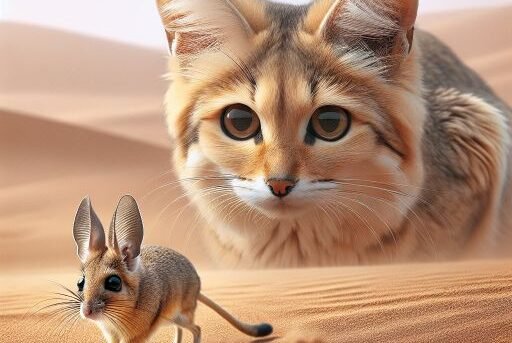Location and Habitat
The sand cat, a small, elusive feline, thrives in the arid deserts of North Africa, the Arabian Peninsula, and Central Asia. Adapted to life in harsh environments, it has thick fur on its paws to protect against hot sands and can survive in temperatures that range from extreme heat during the day to freezing cold at night. Its sandy to yellow-brown coat provides excellent camouflage, allowing it to blend seamlessly into the desert landscape.
On the other hand, the jerboa, a small rodent known for its long hind legs and distinctive hopping movement, inhabits the deserts and steppes of Northern Africa, Asia, and the Arabian Peninsula. These nocturnal creatures create burrows to escape the daytime heat and have evolved long ears that help dissipate heat. Their ability to leap distances many times their body length helps them evade predators, making them a remarkable example of adaptation to desert life.
Sand Cat vs. Jerboa Comparison
| Animal | Size and Weight | Ability to Finish Opponent | Weaponry |
|---|---|---|---|
| Sand Cat | 40-57 cm long, 1.5-3.5 kg | Low (primarily hunts small rodents and birds) | Sharp claws, strong teeth |
| Jerboa | 5-15 cm long, 24-38 g | Very low (mainly avoids predators) | Speed and agility |
“`
Hunting and Skills
The sand cat, a small, elusive feline, primarily hunts small rodents, birds, and reptiles, utilizing its excellent night vision and stealth to stalk and pounce on unsuspecting prey in the desert environment. Its fur-covered feet protect it from the hot sand and aid in silent movement. On the other hand, the jerboa, which is a prey animal, has developed remarkable adaptations for survival, including long hind legs for rapid, bounding escapes, and an ability to burrow quickly into the sand to hide from predators like the sand cat. Jerboas primarily feed on plants, seeds, and insects, foraging under the cover of darkness to avoid daytime predators.
Sand Cat vs. Jerboa Who Would Win?
The sand cat, being a predator, stalks the jerboa, using its superior stealth and camouflage. The jerboa, primarily a prey animal, relies on its agility and speed to evade. The sand cat eventually catches the jerboa due to its hunting skills and quicker reflexes. Winner: Sand Cat with an 80% chance of winning.




